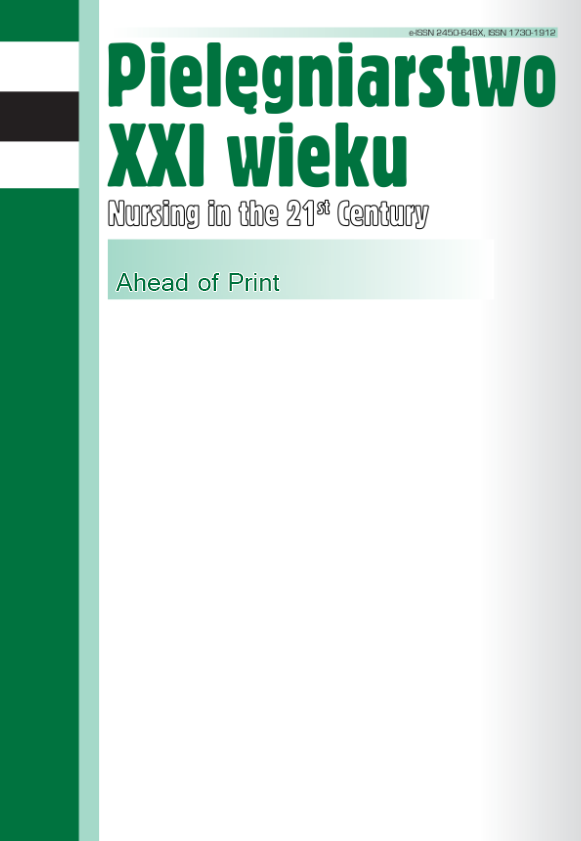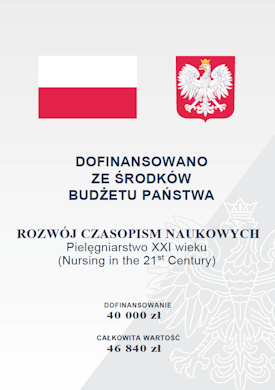Nursing care process for a patient after PCI CTO procedure using PulseCath iVAC 2L based on the ICNP® classification
DOI:
https://doi.org/10.12923/pielxxiw-2025-0016Keywords:
nursing care, percutaneous Coronary Intervention (PCI), Chronic Total Occlusion (CTO), PulseCath iVAC2LAbstract
Cel pracy. Celem pracy było przedstawienie procesu pielęgnowania nad pacjentem po zabiegu PCI CTO z użyciem urządzenia PulseCath iVAC 2L, opartego na klasyfikacji Międzynarodowej Klasyfikacji Praktyki Pielęgniarskiej (ICNP®).
Materiał i metody. Badanie opierało się na studium indywidualnego przypadku, z zastosowaniem wywiadu pielęgniarskiego, obserwacji, analizy dokumentacji medycznej oraz pomiaru podstawowych parametrów życiowych. Zostało przeprowadzone w czerwcu 2024 roku w warunkach szpitalnych, po uzyskaniu zgody pacjenta. Obserwacja trwała 5 dni.
Wyniki. Pacjent, 79-letni mężczyzna z chorobą wieńcową, przeszedł PCI CTO z zastosowaniem urządzenia PulseCath iVAC 2L. Procedura zakończyła się sukcesem, a pacjent nie doznał poważnych powikłań. Po zabiegu pacjent był monitorowany, a jego stan zdrowia uległ poprawie. Przed i po zabiegu obserwowano poprawę parametrów hemodynamicznych.
Wnioski. Wykorzystanie klasyfikacji ICNP® pozwoliło na holistyczne podejście do procesu opieki nad pacjentem, zapewniając systematyczne diagnozowanie i planowanie interwencji pielęgniarskich. Kluczową rolą personelu pielęgniarskiego było monitorowanie stanu pacjenta, zarządzanie bólem oraz zapobieganie powikłaniom, co przyczyniło się do poprawy jakości życia pacjenta po zabiegu.
References
1. Tsao CW, Aday AW, Almarzooq ZI, et al. Heart disease and stroke statistics-2022 update: a report from the american heart association. Circulation. 2022;145(8):e153-e639. https://doi.org/10.1161/CIR.0000000000001052
2. Martin SS, Aday AW, Almarzooq ZI, et al. Heart disease and stroke statistics: a report of us and global data from the american heart association. Circulation. 2024;149(8):e347-e913. https://doi.org/10.1161/CIR.0000000000001209
3. Farag M, Egred M. CTO in contemporary PCI. Curr. Cardiol. Rev. 2022;18(1):e310521193720. https://doi.org/10.2174/1573403X17666210531143519
4. Panuccio G, Abdelwahed YS, Carabetta N, et al. Clinical and procedural outcomes of IVUS-guided vs. angiography-guided CTO-PCI: A systematic review and meta-analysis. J. Clin. Med. 2023;12(15):4947. https://doi.org/10.3390/jcm12154947
5. Azzalini L, Karmpaliotis D, Santiago R, et al. Contemporary issues in chronic total occlusion percutaneous coronary intervention. JACC Cardiovasc. Interv. 2022;15(1):1-21. https://doi.org/10.1016/j.jcin.2021.09.027
6. Abdelwahed YS, Blum E, Landmesser U, et al. CT-guided CTO-PCI overcoming bypass surgery-induced native coronary artery tenting. J. Invasive. Cardiol. 2022;34(6):E486-E487. https://doi.org/10.25270/jic/21.00432
7. Lee SW, Lee PH, Ahn JM, et al. Randomized trial evaluating percutaneous coronary intervention for the treatment of chronic total occlusion. Circulation. 2019;139(14):1674-1683. https://doi.org/10.1161/CIRCULATIONAHA
8. Munirwan H, Kusyanto FA, Zanisa Z, et al. Chronic total occlusion percutaneous coronary intervention (CTO PCI) in an intractable heart failure patient: Is there any benefit? Narra J. 2023;3(2):e140. https://doi.org/10.52225/narra.v3i2.140
9. Van Mieghem NM, Daemen J, Lenzen MJ, et al. The Pulse Cath iVAC 2L left ventricular assist device: conversion to a percutaneous transfemoral approach. EuroIntervention. 2015;11(7):835-839. https://doi.org/10.4244/EIJV11I7A168
10. den Uil CA, Daemen J, Lenzen MJ, et al. Pulsatile iVAC 2L circulatory support in high-risk percutaneous coronary intervention. Euro Intervention. 2017;12(14):1689-1696. https://doi.org/10.4244/EIJ-D-16-00371
11. Cao D, Chandiramani R, Capodanno D, et al. Non-cardiac surgery in patients with coronary artery disease: risk evaluation and periprocedural management. Nat. Rev. Cardiol. 2021;18(1):37-57. https://doi.org/10.1038/s41569-020-0410-z
12. Rolley JX, Rolley JX, Davidson PM, et al. Review of nursing care for patients undergoing percutaneous coronary intervention: a patient journey approach. Journal of Clinical Nursing. 2009;18(17):2394-2405. https://doi.org/10.1111/j.1365¬2702.2008.02768.x
13. Dębska G, Gorzkowicz B, Foryś Z, et al. Continuous professional development of nurses and ICNP® introduction in Poland. Int. J. Occup. Med. Environ. Health. 2020;33(3):353-363. https://doi.org/10.13075/ijomeh.1896.01480
14. Coenen A, Kim TY. Development of terminology subsets using ICNP®. Int. J. Med. Inform. 2010;79(7):530-538. https://doi.org/10.1016/j.ijmedinf.2010.04.003
15. Rabelo-Silva ER, Cavalcanti ACD, Caldas MCRG, et al. Advanced Nursing Process quality: Comparing the International Classification for Nursing Practice (ICNP) with the NANDA-International (NANDA-I) and Nursing Interventions Classification (NIC). J. Clin. Nurs. 2017;26(3-4):379-387. https://doi.org/10.1111/jocn.13387
16. Snoeren M, Verbeek H, Sixma HJ. Standardized nursing language: the development and application of the International Classification for Nursing Practice (ICNP®). J. Clin. Nurs. 2003;12(6):727-732. https://doi.org/10.1046/j.1466-7657.2003.00184.x
Downloads
Published
Issue
Section
License
Copyright (c) 2025 Author

This work is licensed under a Creative Commons Attribution 4.0 International License.




